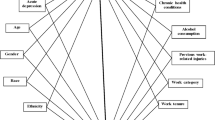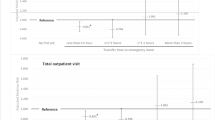Abstract
This study describes hospitalized injuries among workers in British Columbia lumber industry. Between April 1989 and December 1997, from the hospital records of 5,745 male sawmill workers were analyzed for the present study. Work relatedness was determined using either ICD-9 external cause of injury codes, which have a digit-indicating place of occurrence, or a payment field, which can identify workers compensation agency. Poisson regression models were used to analyze differences in hospitalization rates across race, job category, age group, and calendar year. The crude and adjusted rate ratios were calculated along with the 95% confidence intervals (CIs). During the follow-up period, there were 164 work related hospitalization resulting in a rate for work-related hospitalization of 5.38 per 1,000 person years. The higher rates by nature of injury were for dislocation, sprains & strains, open wounds, and fracture of upper limbs. During the study period, the higher rates of injury by causes were machinery related, falls, and struck against. In the multivariate models, there were no statistically significant relationship of injury risk with age and race. In respect to occupation, compared to foremen/supervisor, other sawmills’ workers did not have significantly elevated risk of injury. The trend analyses found a significant negative trend (P = 0.004) of injury risk over the whole study period. Knowing the causes and nature of injury and their related risk factors are helpful to employers, compensation officials, and other stakeholders to target preventive measures.


Similar content being viewed by others
References
Demers PA, Teschke K. Lumber industry, chapter editors. Jeanne MS editor. ILO encyclopedia of occupational health and safety. 4th ed., Vol. III. Geneva, Switzerland: International Labour Organisation; 1998.
BC Statistics. Employment by industry. 2004 [accessed 2004 Mar 20]. Available from: http://www.bcstats.gov.bc.ca/data/dd/handout/naicsann.pdf. .
WCB. Focus report on preventing injuries to workers. Forest products manufacturing. Injury rate in sawmills 1999; p. 23–34.
Waller JA, Payne SR, Skelly JM. Injuries to carpenters. J Occup Med 1989;31:687–92.
Frumkin H, Williamson M, Magid D, Holmes JH, Grisson JA. Occupational injuries in a poor inner-city population. J Occup Environ Med 1995;37:1374–82.
Stanbury M, Joyce P, Kipen H. Silicosis and workers’ compensation in New Jersey. J Occup Environ Med 1995;37:1342–7.
Biddle J, Roberts K, Rosenman KD, Welch EM. What percentage of workers with work-related illnesses receive workers’ compensation benefits? J Occup Environ Med 1998;40:325–31.
Rosenman KD, Gardiner JC, Wang J, Biddle J, Hogan A, Reilly MJ, Roberts K, Welch E. Why most workers with occupational repetitive trauma do not file for workers’ compensation. J Occup Environ Med 2000;42:25–34.
Shannon HS, Lowe GS. How many injured workers do not file claims for workers’ compensation benefits? Am J Ind Med 2002;42:467–73.
Alamgir H, Koehoorn M, Ostry A, Tompa E, Demers PA. How many work-related injuries requiring hospitalization in British Columbia are claimed for workers’ compensation? Am J Ind Med 2006a;49:443–51.
CIHI. Canadian Institute for Health Information. 1999. The CCICD-10 implementation tool kit, 1999. 2004; p. 7.
ICD-9-CM. International classification of diseases, 9th revision, Clinical Modification. Hyattsville, MD: US Department of Health and Human Services; 1979.
Alamgir H, Koehoorn M, Ostry A, Tompa E, Demers P. An evaluation of hospital discharge records as a tool for serious work related injury surveillance. Occup Environ Med 2006b;63:290–6.
Dimich-Ward H, Guernsey JR, Pickett W, Rennie D, Hartling L, Brison RJ. Gender differences in the occurrence of farm related injuries. Occup Environ Med 2004;61:52–6.
Locker AR, Pickett W, Hartling L, Dorland JL. Agricultural machinery injuries in Ontario, 1985–1996: a comparison of males and females. J Agric Saf Health 2002;8:215–23.
Liss GM, Tarlo SM, Macfarlane Y, Yeung KS. Hospitalization among workers compensated for occupational asthma. Am J Respir Crit Care Med 2000;162:112–8.
Hertzman C, Teschke K, Ostry A, Hershler R, Dimich-Ward H, Kelly S, Spinelli JJ, Gallagher RP, McBride M, Marion SA. Mortality and cancer incidence among sawmill workers exposed to chlorophenate wood preservatives. Am J Public Health 1997;87:71–9.
Teschke K, Ostry A, Hertzman C, Demers PA, Barroetavena MC, Davies HW, Dimich-Ward H, Heacock H, Marion SA. Opportunities for a broader understanding of work and health: multiple uses of an occupational cohort database. Can J Public Health 1998;89:132–6.
CHSPR. Centre for Health Services & Policy Research. BC linked health database. 2005 [accessed 2005 Oct 2]. Available from: http://www.chspr.ubc.ca/hidu/.
Chamberlayne R, Green B, Barer ML, Hertzman C, Lawrence WJ, Sheps SB. Creating a population-based linked health database: a new resource for health services research. Can J Public Health 1998;89:270–3.
Punnett L. Case–control study of sawmill injuries in Maine. Final technical report to NIOSH. Lowell, MA; 1994.
NIOSH. Life table analysis system for use on the PC. 2001. Available from: http://www.cdc.gov/niosh/LTAS/install.html.
CDC. Centers for disease control and prevention. Fatal and nonfatal occupational injuries involving wood chippers–United States, 1992–2002. Morb Mortal Wkly Rep 2004;53:1130–1.
Trump TR, Etherton JR. Foreseeable errors in the use of foot controls on industrial machines. Appl Ergon 1985;16:103–11.
Gauchard G, Chau N, Mur JM, Perrin P. Falls and working individuals: role of extrinsic and intrinsic factors. Ergonomics 2001;44:1330–9.
Choi BC, Levitsky M, Lloyd RD, Stones IM. Patterns and risk factors for sprains and strain in Ontario, Canada 1990: an analysis of the Workplace Health and Safety Agency data base. J Occup Environ Med 1996;38:379–89.
Salminen S. Have young workers more injuries than older ones? An international literature review. J Safety Res 2004;35:513–21.
Pransky G, Moshenberg D, Benjamin K, Portillo S, Thackrey JL, Hill-Fotouhi C. Occupational risks and injuries in non-agricultural immigrant Latino workers. Am J Ind Med 2002;42(2):117–23.
Barroetavena MC. An epidemiologic investigation of injury mortality among sawmill workers. [PhD thesis]. Canada: The University of British Columbia; 2001; p. 60–95.
Driscoll TR, Ansari G, Harrison JE, Frommer MS, Ruck EA. Traumatic work-related fatalities in forestry and sawmill workers in Australia. J Safety Res 1995;26:221–33.
Aminoff S. Accidents and accident risks within the sawmill industry. Proceedings of IUFRO joint meeting divisions 3 and 5. Ergonomics in sawmills and woodworking industries. Sweden; 1974.
Larsson TJ. Safety in sawmills: three Swedish studies 1988–1990. Stockholm, Sweden: Institute for Human Safety & Accident Research; 1990.
Laflamme L, Cloutier E. Mechanization and risk of occupational accidents in the logging industry. J Occup Acc 1988;10:191–8.
Cooke W, Blumenstock M. The determinants of occupational injury severity: the case of maine sawmills journal of safety research. J Safety Res 1979;11:115.
Bode CO, Giwa SO, Oke DA. Factory floor injury in a Lagos sawmill. West Afr J Med 2001;20:256–60.
Burridge JD, Marshall SW, Laing RM. Work-related hand and lower-arm injuries in New Zealand, 1979 to 1988. Aust N Z J Public Health 1997;21:451–4.
Vestberg K, Thulstrup AM, Sorensen HT, Ottesen P, Sabroe S, Vilstrup H. Data quality of administratively collected hospital discharge data for liver cirrhosis epidemiology. J Med Syst 1997;21:11–20.
Rawson NS, Malcolm E. Validity of the recording of ischaemic heart disease and chronic obstructive pulmonary disease in the Saskatchewan health care datafiles. Stat Med 1995;14:2627–43.
Kashner TM. Agreement between administrative files and written medical records: a case of the Department of Veterans Affairs. Med Care 1998;36:1324–36.
Beghi E, Logroscino G, Micheli A, Millul A, Perini M, Riva R, Salmoiraghi F, Vitelli E, Italian ALS Registry Study Group. Validity of hospital discharge diagnoses for the assessment of the prevalence and incidence of amyotrophic lateral sclerosis. Amyotroph Lateral Scler Other Motor Neuron Disord 2001;2:99–104.
ICD-10. International statistical classification of diseases and related health problems, 10th revision. Geneva: World Health Organization; 1992–1994.
Author information
Authors and Affiliations
Corresponding author
Rights and permissions
About this article
Cite this article
Alamgir, H., Demers, P.A., Koehoorn, M. et al. Epidemiology of work-related injuries requiring hospitalization among sawmill workers in British Columbia, 1989–1997. Eur J Epidemiol 22, 273–280 (2007). https://doi.org/10.1007/s10654-007-9122-5
Received:
Accepted:
Published:
Issue Date:
DOI: https://doi.org/10.1007/s10654-007-9122-5




